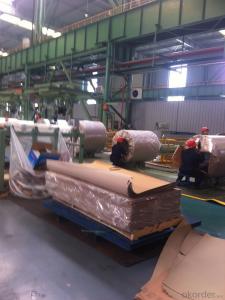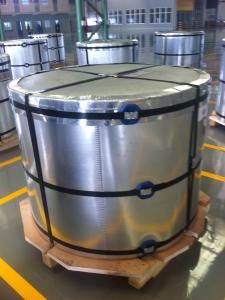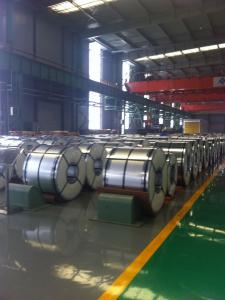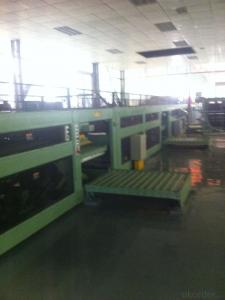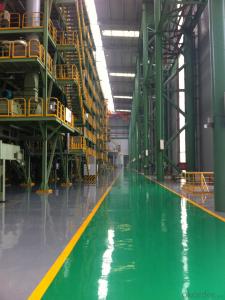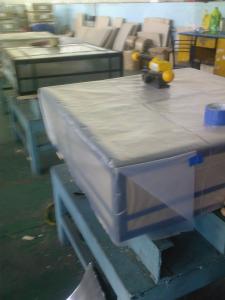Prime Quality Tinplate Sheets for 0.31mm MR
- Loading Port:
- Tianjin
- Payment Terms:
- TT OR LC
- Min Order Qty:
- 25 m.t.
- Supply Capability:
- 20000 m.t./month
OKorder Service Pledge
OKorder Financial Service
You Might Also Like
1.Structure Description
Electrolytic Tinplate Sheets is one of the metal packing materials, which is widely used for making painting cans ,chemical package cans , electrical cable ,battery and metal printing etc.
2. Main Features
Steady and high quality
Fast shipment
Good experience for export work
For the surface, Plate uniform in thickness,uniform and smooth tin coating, without flaws,rusts,scratch,wave,nick of tin coating etc.
Price competitive
3.Images

4. Specification
Standard : GB2520-2000 ,JIS G3303
Steel type : SPCC
Coating : 2.8/2.8
Surface: Bright, Stone ,
Thickness:0.26
Width :600MM~1000MM
Temper : T1~T5
Package: tinplate wrapped completely with an inner cover of plastic or waterproof papers with vorners protected with metal angels.
5.FAQ
A. What is the package of tinplate? (Referred as below)
For sheets, thin plastic film + rust-proof paper + metallic cover + metallic angles+ steel band strips + fumigated wooden pallet.
For coil, thin plastic film + rust proof paper + metallic cover + steel band strips + fumigated wooden pallet
B. The surface of tinplate could you supply?
Stone finish, Bright finish, Matte finish, Silver finish
C. What quantity is the minimum order of tinplate?
Usually, the minimum quantity is 25MT. For special case, consult with us.
D. Can it make to be BA or CA for annealing?
Yes, both can do with.
- Q: What are the regulations regarding tinplate packaging?
- Tinplate packaging is subject to various regulations, depending on the country and specific product being packaged. These regulations typically cover aspects such as food safety, labeling requirements, and environmental considerations. For example, in the United States, the Food and Drug Administration (FDA) regulates tinplate packaging for food products, ensuring they meet safety standards and are properly labeled. Additionally, there may be specific regulations related to recycling or disposal of tinplate packaging to minimize its impact on the environment. It is essential for businesses to research and comply with the relevant regulations to ensure their tinplate packaging meets all necessary requirements.
- Q: How does tinplate contribute to the conductivity of electrical components?
- Tinplate contributes to the conductivity of electrical components by acting as a protective coating, preventing corrosion and oxidation of the underlying metal. This ensures a consistent flow of electrical current and enhances the overall conductivity of the component.
- Q: How does tinplate packaging impact brand image and perception?
- Tinplate packaging can have a positive impact on brand image and perception. Its durability and premium appearance can convey a sense of quality and sophistication, enhancing the overall image of the brand. Additionally, tinplate packaging is often associated with sustainability as it is recyclable, which can further improve the brand's perception among environmentally conscious consumers.
- Q: What are the different printing techniques used on tinplate?
- Some of the different printing techniques used on tinplate include lithography, offset printing, screen printing, and digital printing.
- Q: Can tinplate be used for packaging products with sharp edges?
- Yes, tinplate can be used for packaging products with sharp edges. Tinplate is known for its durability and strength, making it suitable for packaging products that have sharp edges without causing any damage to the packaging material.
- Q: What are the advantages of using tinplate for aerosol cans?
- Some advantages of using tinplate for aerosol cans include its durability, corrosion resistance, and ability to maintain product quality. Tinplate cans offer a longer shelf life for aerosol products as they prevent air and moisture from entering the can, ensuring the product remains fresh and effective. Additionally, tinplate cans are lightweight, making them convenient for transportation and storage. They are also recyclable, contributing to sustainability efforts.
- Q: How does tinplate affect the environment?
- Tinplate can have both positive and negative impacts on the environment. On one hand, tinplate is a highly recyclable material, which helps reduce the demand for new raw materials and decreases waste generation. Additionally, tinplate is often used as a protective coating on steel cans, preventing corrosion and extending their lifespan. This contributes to reducing the need for frequent replacements and conserving resources. However, the production of tinplate involves mining and refining tin ore, which can lead to habitat destruction, soil erosion, and water pollution if not managed properly. Furthermore, the manufacturing process may emit greenhouse gases and other air pollutants. Overall, the impact of tinplate on the environment depends on various factors, including its lifecycle management and the efficiency of recycling processes.
- Q: How does the printing process affect the durability of tinplate?
- The printing process can have both positive and negative effects on the durability of tinplate. On one hand, the application of a protective coating during the printing process can enhance the tinplate's resistance to corrosion, scratches, and other forms of damage. This can significantly improve its overall durability. On the other hand, if the printing process is not done properly or if low-quality inks or coatings are used, it can weaken the tinplate's protective layer, making it more prone to wear and tear. Therefore, the printing process plays a crucial role in determining the durability of tinplate.
- Q: How is tinplate printed and decorated?
- Tinplate is typically printed and decorated through a process called lithography. This involves creating a design on a flat surface, often using a metal plate, which is then transferred onto the tinplate using ink. Various techniques such as offset printing or screen printing can be employed to achieve different effects and colors. Additionally, other decorative elements like embossing or varnishing may be applied to enhance the visual appeal of the tinplate.
- Q: How does tinplate compare to other packaging materials in terms of shelf appeal?
- Tinplate stands out among other packaging materials in terms of shelf appeal due to its unique combination of durability, versatility, and aesthetic appeal. Its shiny surface and smooth finish make products packaged in tinplate visually appealing, catching the attention of consumers. Additionally, tinplate allows for intricate and vibrant designs, enhancing the overall attractiveness of the packaging. Moreover, the robustness and long shelf life of tinplate ensure that the packaging remains intact, preserving the product's visual appeal throughout its lifespan.
Send your message to us
Prime Quality Tinplate Sheets for 0.31mm MR
- Loading Port:
- Tianjin
- Payment Terms:
- TT OR LC
- Min Order Qty:
- 25 m.t.
- Supply Capability:
- 20000 m.t./month
OKorder Service Pledge
OKorder Financial Service
Similar products
Hot products
Hot Searches
Related keywords
